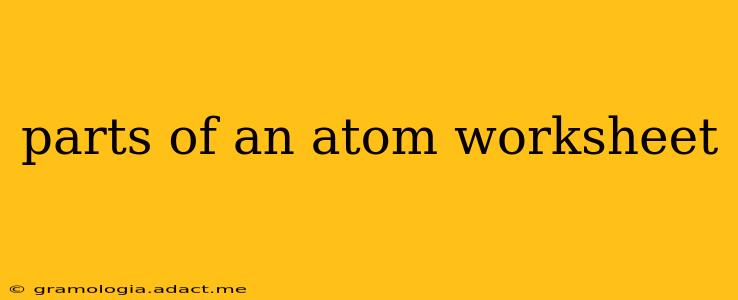This worksheet will guide you through the fascinating world of atoms, the fundamental building blocks of matter. We'll explore their constituent parts and delve into their properties. By the end, you'll have a solid understanding of atomic structure.
What is an Atom?
Before we dive into the parts, let's define what an atom is. An atom is the smallest unit of an element that retains the chemical properties of that element. Think of it as the basic LEGO brick from which all matter is built. Everything around you, from your computer screen to the air you breathe, is made up of atoms!
The Three Main Subatomic Particles
Atoms are composed of three primary subatomic particles:
- Protons: Positively charged particles found in the atom's nucleus (center). The number of protons determines the element's atomic number and its identity.
- Neutrons: Neutrally charged particles (no charge) also residing in the atom's nucleus. Neutrons contribute to the atom's mass but not its charge.
- Electrons: Negatively charged particles orbiting the nucleus in electron shells or energy levels. Electrons are much smaller and lighter than protons and neutrons.
How many protons, neutrons, and electrons are in a specific atom?
To determine the number of each subatomic particle in a specific atom, you need to know its atomic number and mass number.
- Atomic Number: This is the number of protons in the atom's nucleus. It uniquely identifies the element. You can find this number on the periodic table.
- Mass Number: This is the total number of protons and neutrons in the atom's nucleus. It represents the atom's approximate mass.
The number of electrons in a neutral atom is equal to the number of protons. If an atom gains or loses electrons, it becomes an ion (a charged atom).
What are isotopes?
Isotopes are atoms of the same element that have the same number of protons but a different number of neutrons. This means they have the same atomic number but a different mass number. For example, carbon-12 and carbon-14 are isotopes of carbon. They both have 6 protons, but carbon-12 has 6 neutrons, while carbon-14 has 8 neutrons.
How are electrons arranged?
Electrons are arranged in shells or energy levels surrounding the nucleus. Each shell can hold a specific number of electrons. The first shell can hold up to 2 electrons, the second shell up to 8, and so on. The arrangement of electrons in an atom determines its chemical properties and how it interacts with other atoms.
What is the atomic nucleus?
The atomic nucleus is the dense central region of an atom, containing protons and neutrons. It is incredibly small but holds almost all of the atom's mass. The strong nuclear force holds the protons and neutrons together in the nucleus, overcoming the electrostatic repulsion between the positively charged protons.
What are ions?
Ions are atoms that have gained or lost electrons, resulting in a net electric charge. A positive ion (cation) has lost electrons, while a negative ion (anion) has gained electrons. The formation of ions is crucial in many chemical reactions.
Practice Problems
-
An atom of oxygen has an atomic number of 8 and a mass number of 16. How many protons, neutrons, and electrons does it have?
-
What is the difference between an atom and an ion?
-
Explain the concept of isotopes with an example.
-
Draw a simple diagram of an atom, labeling its parts.
-
Why is the atomic number important in identifying an element?
This worksheet provides a foundation for understanding the parts of an atom. Remember to consult your textbook and other resources for further information. Understanding atomic structure is fundamental to comprehending chemistry and the world around us!
